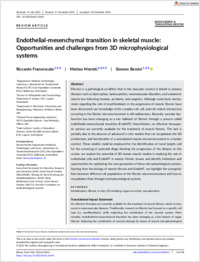Endothelial-mesenchymal transition in skeletal muscle : opportunities and challenges from 3D microphysiological systems
- Francescato, Riccardo ORCID Regenerative Medicine Technologies Laboratory, Laboratories for Translational Research (LRT), Ente Ospedaliero Cantonale (EOC), Bellinzona, Switzerland - Service of Orthopaeerdics and Traumatology, Department of Surgery, EOC, Lugano, Switzerland - Department of Electronics, Information and Bioengineering, Politecnico di Milano, Milano, Italy
- Moretti, Matteo Regenerative Medicine Technologies Laboratory, Laboratories for Translational Research (LRT), Ente Ospedaliero Cantonale (EOC), Bellinzona, Switzerland - Service of Orthopaeerdics and Traumatology, Department of Surgery, EOC, Lugano, Switzerland - Cell and Tissue Engineering Laboratory, IRCCS Ospedale Galeazzi Sant'Ambrogio, Milano, Italy - Euler Institute (EUL), Università della Svizzera italiana, Switzerland
- Bersini, Simone ORCID Regenerative Medicine Technologies Laboratory, Laboratories for Translational Research (LRT), Ente Ospedaliero Cantonale (EOC), Bellinzona, Switzerland - Service of Orthopaedics and Traumatology, Department of Surgery, EOC, Lugano, Switzerland - Euler Institute (EUL), Università della Svizzera italiana, Switzerland
- 2024
Published in:
- Bioengineering and translational medicine. - 2024, no. 10644
English
Fibrosis is a pathological condition that in the muscular context is linked to primary diseases such as dystrophies, laminopathies, neuromuscular disorders, and volumetric muscle loss following traumas, accidents, and surgeries. Although some basic mechanisms regarding the role of myofibroblasts in the progression of muscle fibrosis have been discovered, our knowledge of the complex cell–cell, and cell–matrix interactions occurring in the fibrotic microenvironment is still rudimentary. Recently, vascular dysfunction has been emerging as a key hallmark of fibrosis through a process called endothelial-mesenchymal transition (EndoMT). Nevertheless, no effective therapeutic options are currently available for the treatment of muscle fibrosis. This lack is partially due to the absence of advanced in vitro models that can recapitulate the 3D architecture and functionality of a vascularized muscle microenvironment in a human context. These models could be employed for the identification of novel targets and for the screening of potential drugs blocking the progression of the disease. In this review, we explore the potential of 3D human muscle models in studying the role of endothelial cells and EndoMT in muscle fibrotic tissues and identify limitations and opportunities for optimizing the next generation of these microphysiological systems. Starting from the biology of muscle fibrosis and EndoMT, we highlight the synergistic links between different cell populations of the fibrotic microenvironment and how to recapitulate them through microphysiological systems.
- Collections
- Language
-
- English
- Classification
- Medicine
- License
- Open access status
- green
- Identifiers
-
- DOI 10.1002/btm2.10644
- ARK ark:/12658/srd1328393
- Persistent URL
- https://n2t.net/ark:/12658/srd1328393
Statistics
Document views: 161
File downloads:
- Francescato_2024_bioengtranslmed: 287
